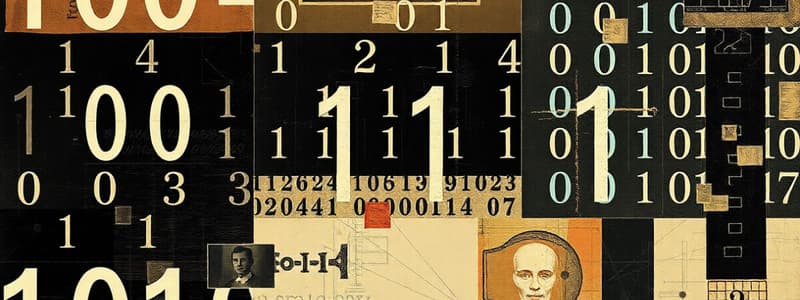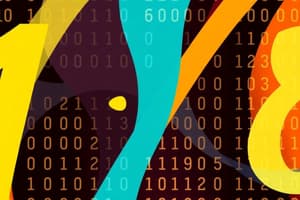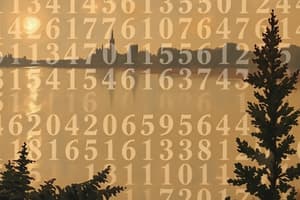Podcast
Questions and Answers
What is the main characteristic of analog data?
What is the main characteristic of analog data?
- It is a discrete representation
- It is a continuous representation (correct)
- It is processed using binary digits
- It can be directly used by computers
Why can computers not work with analog information directly?
Why can computers not work with analog information directly?
- Analog information must be digitized (correct)
- Analog information is too complex for computers
- Analog information requires a continuous power source
- Analog information is always incorrect
Which of the following best describes digital data?
Which of the following best describes digital data?
- It is stored in a continuous flow
- It is more prone to degradation than analog data
- It consists of separate, discrete elements (correct)
- It operates independently from binary digits
What type of device is exemplified by a mercury thermometer?
What type of device is exemplified by a mercury thermometer?
What is a key goal of data representation in computing systems?
What is a key goal of data representation in computing systems?
How do electronic signals, both analog and digital, behave as they travel?
How do electronic signals, both analog and digital, behave as they travel?
Which of the following best describes the process of digitizing analog information?
Which of the following best describes the process of digitizing analog information?
Which statement about binary digits is correct?
Which statement about binary digits is correct?
What happens to information in an analog signal as it degrades?
What happens to information in an analog signal as it degrades?
How does a digital signal differ from an analog signal in terms of degradation?
How does a digital signal differ from an analog signal in terms of degradation?
What process is used to restore the shape of a digital signal during degradation?
What process is used to restore the shape of a digital signal during degradation?
What defines the threshold for a digital signal?
What defines the threshold for a digital signal?
What is the main consequence of fluctuating voltage in an analog signal?
What is the main consequence of fluctuating voltage in an analog signal?
What effect does a larger base have on the representation of numbers?
What effect does a larger base have on the representation of numbers?
In binary, what decimal number does the binary number 101 represent?
In binary, what decimal number does the binary number 101 represent?
What is the decimal equivalent of the binary number 110?
What is the decimal equivalent of the binary number 110?
What is the result of multiplying 3 and 6 in base 10?
What is the result of multiplying 3 and 6 in base 10?
Which base does not use the digits 8 and 9?
Which base does not use the digits 8 and 9?
How many symbols are used in base 10?
How many symbols are used in base 10?
What is the decimal equivalent of the base 2 number 1001?
What is the decimal equivalent of the base 2 number 1001?
What is the result of 3 + 4 in base 10?
What is the result of 3 + 4 in base 10?
In base 10, what is the outcome of 5 x 7?
In base 10, what is the outcome of 5 x 7?
What is the decimal (base 10) equivalent of the number 5278?
What is the decimal (base 10) equivalent of the number 5278?
How many different digits are represented in base 6?
How many different digits are represented in base 6?
What is the largest digit in base 6?
What is the largest digit in base 6?
What would be the next value after 21z in base 6 when counting up by 1's, where z is the largest digit?
What would be the next value after 21z in base 6 when counting up by 1's, where z is the largest digit?
Which method is used for converting a number from base B to base 10 using successive multiplication?
Which method is used for converting a number from base B to base 10 using successive multiplication?
Which statement most accurately reflects how operations in any number base relate to base 10?
Which statement most accurately reflects how operations in any number base relate to base 10?
Which of the following best describes the least significant digit in any number base?
Which of the following best describes the least significant digit in any number base?
In the informal method of converting numbers from base B to base 10, what primary action is performed?
In the informal method of converting numbers from base B to base 10, what primary action is performed?
Which numeral system is based on powers of 2?
Which numeral system is based on powers of 2?
What is the range of values for a 16-bit number?
What is the range of values for a 16-bit number?
In the hexadecimal system, which numerals are used?
In the hexadecimal system, which numerals are used?
What is the equivalent decimal value of the binary number 1101 0110?
What is the equivalent decimal value of the binary number 1101 0110?
Which base is used in the octal number system?
Which base is used in the octal number system?
How many distinct symbols are used in the base 10 numeral system?
How many distinct symbols are used in the base 10 numeral system?
What is the value of the numeral '64' in the octal number system when converted to decimal?
What is the value of the numeral '64' in the octal number system when converted to decimal?
Which formula represents the range of possible numbers in a numeral system?
Which formula represents the range of possible numbers in a numeral system?
What decimal number does the binary number 1010 represent?
What decimal number does the binary number 1010 represent?
In a hexadecimal number, what is the value of 'A'?
In a hexadecimal number, what is the value of 'A'?
How many different numbers can be represented with a 20-bit system?
How many different numbers can be represented with a 20-bit system?
If the base is 2 and K is 4, what is the range of numbers?
If the base is 2 and K is 4, what is the range of numbers?
Which of the following represents the decimal value of the hexadecimal number '1F'?
Which of the following represents the decimal value of the hexadecimal number '1F'?
What does the term 'base' refer to in numerals systems?
What does the term 'base' refer to in numerals systems?
What is the result of multiplying $38$ and $68$ in base 8?
What is the result of multiplying $38$ and $68$ in base 8?
In octal addition, what is the sum of $6 + 1$?
In octal addition, what is the sum of $6 + 1$?
Which statement is true regarding binary addition?
Which statement is true regarding binary addition?
What is the largest single digit in hexadecimal addition?
What is the largest single digit in hexadecimal addition?
Which operation is used for binary multiplication?
Which operation is used for binary multiplication?
How is the sum calculated in base 10 when adding $6 + 4$?
How is the sum calculated in base 10 when adding $6 + 4$?
What is the conversion of decimal $42$ to binary?
What is the conversion of decimal $42$ to binary?
When converting from base 10 to base 8, what is the remainder of $7263$ when divided by $8$?
When converting from base 10 to base 8, what is the remainder of $7263$ when divided by $8$?
What is the binary representation of hex value $1F67$?
What is the binary representation of hex value $1F67$?
What is the first step in converting the number $8,039$ from base 10 to base 16?
What is the first step in converting the number $8,039$ from base 10 to base 16?
What is the least significant bit when converting the decimal number $42$ to binary?
What is the least significant bit when converting the decimal number $42$ to binary?
What is the result of converting the octal number $7263_8$ to decimal?
What is the result of converting the octal number $7263_8$ to decimal?
How does the exclusive-OR logic function work?
How does the exclusive-OR logic function work?
Flashcards
Analog signal
Analog signal
A continuous representation of information, similar to the real-world information it represents.
Digital signal
Digital signal
A discrete representation of information, made up of separate pieces or elements.
Data representation in computers
Data representation in computers
The way information is encoded inside a computer using a limited set of symbols (usually binary digits).
Digitization
Digitization
Signup and view all the flashcards
Binary Digits
Binary Digits
Signup and view all the flashcards
Analog data example
Analog data example
Signup and view all the flashcards
Digital representation
Digital representation
Signup and view all the flashcards
Finite machine
Finite machine
Signup and view all the flashcards
Analog Signal Degradation
Analog Signal Degradation
Signup and view all the flashcards
Digital Signal Degradation
Digital Signal Degradation
Signup and view all the flashcards
Reclocking of Digital Signals
Reclocking of Digital Signals
Signup and view all the flashcards
Binary System
Binary System
Signup and view all the flashcards
Threshold in Digital Signals
Threshold in Digital Signals
Signup and view all the flashcards
Base
Base
Signup and view all the flashcards
Larger Base
Larger Base
Signup and view all the flashcards
Binary Number System
Binary Number System
Signup and view all the flashcards
Counting in Binary
Counting in Binary
Signup and view all the flashcards
Base 10 Addition Table
Base 10 Addition Table
Signup and view all the flashcards
Base 8 Addition Table
Base 8 Addition Table
Signup and view all the flashcards
Base 10 Multiplication Table
Base 10 Multiplication Table
Signup and view all the flashcards
Place Value in a Base
Place Value in a Base
Signup and view all the flashcards
Converting a Number to a Different Base
Converting a Number to a Different Base
Signup and view all the flashcards
Number Representation in Different Bases
Number Representation in Different Bases
Signup and view all the flashcards
Positional Notation
Positional Notation
Signup and view all the flashcards
Decimal System
Decimal System
Signup and view all the flashcards
Octal System
Octal System
Signup and view all the flashcards
Hexadecimal System
Hexadecimal System
Signup and view all the flashcards
Place Value
Place Value
Signup and view all the flashcards
527 in Base 10
527 in Base 10
Signup and view all the flashcards
624 in Octal
624 in Octal
Signup and view all the flashcards
6,704 in Hexadecimal
6,704 in Hexadecimal
Signup and view all the flashcards
1101 0110 in Binary
1101 0110 in Binary
Signup and view all the flashcards
Range of numbers
Range of numbers
Signup and view all the flashcards
Number of Symbols
Number of Symbols
Signup and view all the flashcards
Radix
Radix
Signup and view all the flashcards
16-bit PC Range
16-bit PC Range
Signup and view all the flashcards
Largest Digit in Base 6
Largest Digit in Base 6
Signup and view all the flashcards
Counting in Base 6
Counting in Base 6
Signup and view all the flashcards
Converting Base 6 to Base 10
Converting Base 6 to Base 10
Signup and view all the flashcards
Base 10 Representation of 5278 (Base 6)
Base 10 Representation of 5278 (Base 6)
Signup and view all the flashcards
What is the next value after 215 (base 6)?
What is the next value after 215 (base 6)?
Signup and view all the flashcards
What is the next value after 455 (base 6)?
What is the next value after 455 (base 6)?
Signup and view all the flashcards
Base Conversion Methods
Base Conversion Methods
Signup and view all the flashcards
Largest Single Digit in Base 8
Largest Single Digit in Base 8
Signup and view all the flashcards
Carry in Addition (Base 8)
Carry in Addition (Base 8)
Signup and view all the flashcards
Binary Arithmetic
Binary Arithmetic
Signup and view all the flashcards
XOR (Exclusive OR) in Binary
XOR (Exclusive OR) in Binary
Signup and view all the flashcards
AND in Binary (Carry Bit)
AND in Binary (Carry Bit)
Signup and view all the flashcards
Converting from Base 10 to Base 2
Converting from Base 10 to Base 2
Signup and view all the flashcards
Powers Table (Base Conversion)
Powers Table (Base Conversion)
Signup and view all the flashcards
Nibble Approach (Base 16 to Base 2)
Nibble Approach (Base 16 to Base 2)
Signup and view all the flashcards
From Base 8 to Base 10
From Base 8 to Base 10
Signup and view all the flashcards
Converting from Base 16 to Base 2
Converting from Base 16 to Base 2
Signup and view all the flashcards
The Importance of Hexadecimal (Base 16)
The Importance of Hexadecimal (Base 16)
Signup and view all the flashcards
Converting from Base 10 to Base 16
Converting from Base 10 to Base 16
Signup and view all the flashcards
Study Notes
Operating Systems & Computer Architecture: Data Representation
- The presentation covers digital and analog signals, number representation, number bases, number base arithmetic, and number base conversion.
- Learning outcomes include comparing and differentiating between analog and digital signals, explaining data representation, storage, and manipulation within a computer, and performing number base conversions.
- Key terms include base, binary arithmetic, binary number, binary point, binary-decimal conversion, binary-hexadecimal conversion, binary-octal conversion, bit, decimal point, decimal-binary conversion, fractional conversion, hexadecimal-binary conversion, hexadecimal number, left shift, mixed number conversion, octal number, radix point, and right shift.
- Computing systems are finite machines with limited information storage capacity. Their goal is representing real-world data. Information can be represented as either analog or digital.
- Analog data is a continuous representation. For example, a mercury thermometer's mercury level changes continuously in proportion to temperature.
- Digital data is a discrete representation, breaking information into separate elements. Computers require digitization of analog information into binary digits.
- Digital signals degrade less when transmitted across a line than analog. This is due to digital signals sharply jumping between high and low states.
- Digital signals can be reclocked to regain their original shape after degradation, which does not apply to analog signals.
- Early computer design was decimal but John Von Neumann introduced binary data processing in 1945. This binary system is simpler to design and based on switching between on and off, used to perform calculations through Boolean logic.
- The decimal system is base 10, using digits from 0-9. The binary system is base 2, using digits 0 and 1. The octal system is base 8 (0-7). The hexadecimal system is base 16 (0-9, A-F).
- Bits are commonly stored and manipulated in groups of 8 bits (1 byte), 4 bytes (1 word). The number of bits used affects accuracy and limits the size of numbers a computer can handle, like impacting computer graphics.
- Game consoles have evolved using more bits for their processors such as 8 bits to 64 bits and greater.
- Different numerals can represent the same number of quantities. For example; |||| and IV represent 4. However, different bases imply the same quantity using different number of digits (|||| represents 4 in base 1, and IV represents 4 in base 10).
- Modern number systems are based on positional notation, where each digit has a different value depending on its position. This is further explained through examples of base 10, base 8, and base 16. Examples of positional notation are illustrated further through examples using binary.
- The range of possible numbers based on the base and the number of digits. For example, a 16-bit PC can store 65,536 distinct values.
- Conversion methods between bases and arithmetic tables for each base are provided for various bases. Examples show decimal to binary, decimal to hexadecimal, and octal to decimal conversions.
- Addition, multiplication, and XOR/AND Boolean arithmetic functions are demonstrated.
- Converting between bases 10, 2, and 16 are demonstrated and explained.
- Methods for converting numbers between base 8 and base 10 are provided.
Additional Information
- The presentation concludes with Q&A and a segue to the next topic, logic gates.
Studying That Suits You
Use AI to generate personalized quizzes and flashcards to suit your learning preferences.




